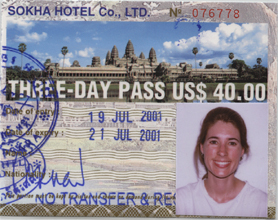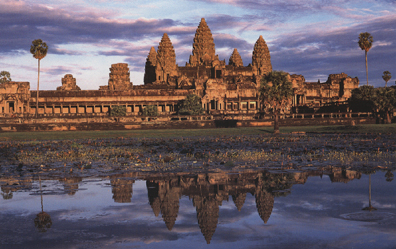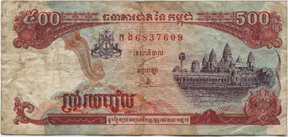
Dmitri says
Poverty, suffering, corruption and beauty.
Not the sexiest lead for a blurb on a foreign country, but an accurate one for Cambodia, I think. It has to be one of the most war-torn places on earth. These people have just had the hell beaten out of them by their neighbors, and even worse, by their own leaders. The Khmer Rouge years destroyed what was left of an amazing ancient culture, and you can see everywhere that the place is a shell of what it should be. The streets are dirt, land mine amputees beg for money everywhere, and the military runs the few things that make any money, taking all of the profits for their own pockets. Oh, and we bombed them as well. It’s just depressing as hell. The first thing you get is some bogus tax on leaving the airplane, and it’s collected by a bunch of military types, cash only, US dollars, please. Yeah, like that money’s going to end up building roads or schools.
So why go? First off, the people are the same as they are anywhere: good. Cambodians are nice, polite and know the truth about the way the world is in a way that makes you at once guilty, smarter and better off. Second, there’s Angkor.
I’ve wanted to see Angkor since seeing pictures of it in a National Geographic magazine when I was 10. It is as magnificent as I’d hoped. Massive, sprawling temples and complexes of stone, statues and causeways give proof that an incredible civilization once dwelt here. You can’t help but be awestruck seeing jungle roots growing through walls, giant lagoon moats, and incredible sunsets over the jungle and the temples cresting the hills. It’s no wonder they shot Tomb Raider here, or why novelists have been inspired to use it as the de facto model for jungle majesty and intrigue.
So I say go there. It’s tragic, but you can learn more about what’s happened there. Nothing changes your perspective on foreign policy like travel. And prepare to be amazed by Angkor.

We left Angkor Wat and climbed up this steep hill to Phnom Bakheng, where there were even better views. After the hill climb and yet even more steep steps, spectucular does not begin to describe it. Far off, we could see Angkor Wat through the trees and the mist and it looked surreal, emerging from the jungle. We were there for the sunset and it was crowded, little mystery why, but a great way to end our first day in Cambodia. Back at the hotel, we took a dip in the pool to cool off and then walked through the dusty streets to a little restaurant called the Soup Dragon. I was sitting with my back to the street—we sat outside—and amputee beggars kept walking by and just standing there watching us. Very creepy. They had scrumptious spring rolls at this restaurant—possibly the best I have ever had. Yummy Angkor beer. (We tried the local beer every place we went.)


There is a tension/coexistence of Hinduism and Buddhism everywhere. Buddhist temples were built, hindu kings come along, remove Buddha statues, and replace them with likenesses of the king. Hindu was there first and Buddhist temples were built on top of them by Jayavarma the 7th. There are lots of carvings of dancers. I think they are called Apsas. Serpents are nagas and there are lots of statues of Garuda. Vishnu is on top of Garuda, but has usually been worn off. Nagas sometimes shelter the Buddha. There are big pools on the grounds, but only for the king. (At the Central Palace) There is a smaller (but still pretty big) bathing pool for the queen. The water was pretty nasty looking, but we were told that at the time of the king, the water was clear. We walked to Baphuon, which was being restored, and over to the Holy Healing Palace. We then walked to the Terrace of the Leper King. Place of amnesty of justice. We also saw the Terrace of the Elephant King and were told that elephants used to fight—like cockfights. We saw pig fights on the reliefs at Bayon. While B was taking us around, Raymond was off meeting up with his girlfriend.




These giant strangler figs have grown through some of the more remote temples. At this point, the temples cannot be restored since the trees are actually holding the walls in place. See Cindy for scale.

Cindy’s Journal
Siem Reap, Cambodia
July 19-21
Flights from Bangkok leave hourly for Siem Reap and are an easy way to get to the temples at Angkor. You used to have to fly to Phnom Pen and take a ferry across, but now it’s relatively easy. We had just a few days in Cambodia and they were plenty. We got to see the temples and then we were outta there. Siem Reap has a tiny airport. Banana Republic evident. Military police were collecting our visa fees—payable only in U.S. dollars. Best not get a visa before going there since chances are they will make you buy one from them anyway—that’s what we were told and it seemed to be good advice. What a racket. We arranged for a driver who helped us find a hotel. Our driver is Raymond, who is a law student. He is very poor, like most of the people in Cambodia.
The level of poverty we saw in this country is like no other. Mine victims are obvious everywhere. There are potholes, dirt streets, and the town is very dusty. It is a tourist trap with no middle class—the very rich and the very poor. Raymond was very excited to meet Americans and told us all about how Tomb Raider had been filmed there. He told us he would point out spots where it was filmed. He said Angelina Jolie was “very tall and very beautiful.” Raymond kept apologizing for his bad English, which was actually very good. He was very solicitous and it made us uncomfortable after awhile—we never got used to him jumping and running and hurrying to get us settled and open our car doors. We had a quick and bad lunch outside Angkor Wat and then roamed the temple. It was hot, but there was some shade and a light breeze. We climbed steep stairs to the top of central Angkor Wat. I am not good with heights and was very scared, but the views were incredible.

The next morning, Raymond picked us up early from the Neak Pean Hotel and we set off for a day of sighseeing. We also hired a tour guide, B, for the day to give us some history of the place. Breakfast was uninteresting except for a soursop, which is a fruit like a white kiwi.
We were off to Angkor Thom. B was a very thorough tour guide who knew a lot and was eager to teach us. At Angkor Thom, there is a long entrance over a causeway lined with statues of gods and demons. It really looks like the entrance to a lost city. Dmitri said that it reminded him of large sequoias. We drove to Bayon—a temple in the center of the Angkor Thom complex. Giant face carvings dominate the temple. Tomb Raider scenes pointed out.

This is Bayon. See the face carvings in the towers. Those damn things were everywhere. It was this one king (Jayarvarma the something-or-other) who wanted his image all over. Overcompensating, perhaps?

We had lunch at a place called New Bayon. We had chicken curry in a coconut and Thai spicy rice. In the middle of the day, we went back to the hotel for a big nap to try to avoid the horrific mid-day heat. Raymond and B came back to collect us at 3 and we were off to Banteay Kdei. It was a temple that the king built for his teacher. It was across from a big lake which was a swimming hole for local kids. From here, we headed off to Ta Prohm, which was the favorite by far. Very cool. The tree roots mingled with the temple. B pointed out again where Tomb Raider was filmed. It is very jungly and overgrown. Has a Jungle Book vibe. Temple of the Monkeys—when the king left the temple, the monkeys moved in. While we were there, we overheard this horrible older English man asking his guide where he could get a young boy. Just awful. The guide told him that this was not Thailand so we thought that was pretty funny.
B told us that he enjoys being a guide, but he doesn’t like to show around French or Thai people because they have a different version of Cambodian history and they cause problems when he tries to tell about the temples and the history. Apparently, Thais say that they built Angkor Wat—but they are wrong according to B and the Rough Guide. On the way back to town, we stopped at a little market to stock up on goodies. We discovered Horlick’s biscuits, which we haven’t been able to find since then. They are incredibly yummy. We planned to go back the next day to get some more, but never made it back.
We had dinner at a place called the Red Piano. We had samosas, prawn spring rolls, loklak—a beef and onion dish with rice. And, of course, Angkor Beer. It was a wonderful place with large wicker chairs where we relaxed after dinner for a couple of hours, reading our books.




 dmitri.usc@gmail.com
dmitri.usc@gmail.com